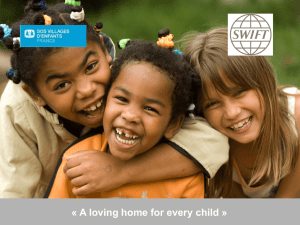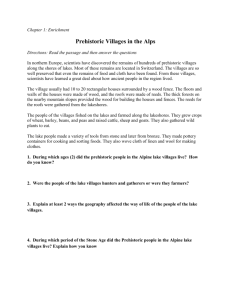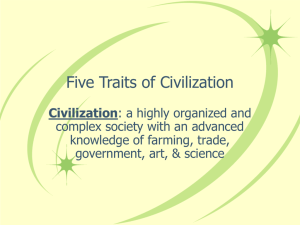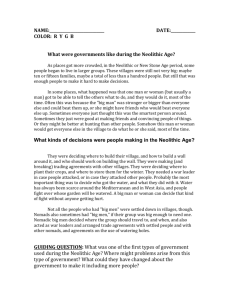Introduction: Context Analysis
advertisement
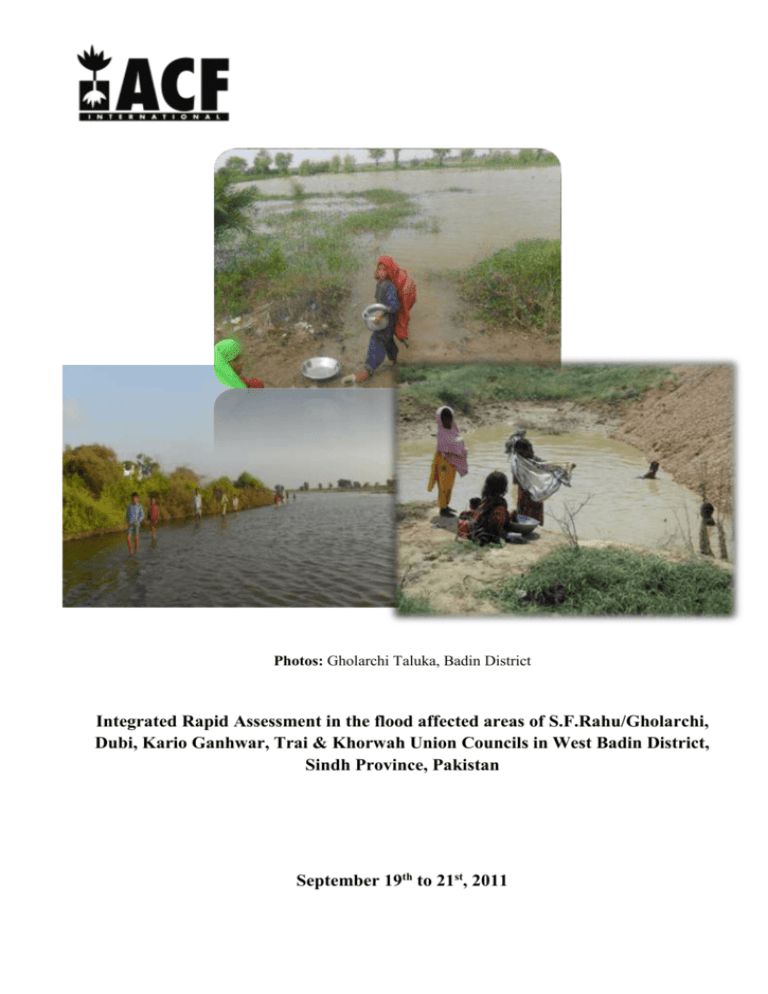
Pakistan Photos: Gholarchi Taluka, Badin District Integrated Rapid Assessment in the flood affected areas of S.F.Rahu/Gholarchi, Dubi, Kario Ganhwar, Trai & Khorwah Union Councils in West Badin District, Sindh Province, Pakistan September 19th to 21st, 2011 Contents Introduction: Context Analysis .................................................................................. ……………………..…………4 Badin District................................................................................................................................................3 1. RATIONAL FOR CURRENT ASESSMENT……………………………….……………………………………………………………….5 1.2 Objectives ............................................................................................................................................ 6 1.3 Methodology ....................................................................................................................................... 6 2. FINDINGS............................................................................................................................................... ….8 2.2 Population affected............................................................................................................................. 8 2.3 Expected length of stay ....................................................................................................................... 8 2.4 Accessibility of the areas ..................................................................................................................... 8 2.5 Ongoing Relief activities ...................................................................................................................... 9 3. WaSH (Damages and needs):.................................................................................................................... 9 3.1 Access to safe drinking water ............................................................................................................. 9 3.2 Potential Water sources and feasibility of water trucking ............................................................... 10 3.3 Access to sanitary facilities ............................................................................................................ 10 3.4 WaSH related diseases. ..................................................................................................................... 11 3.5 People in need of Hygiene kits.......................................................................................................... 12 4. FOOD SECURITY AND LIVELIHOODS (Damages and Needs) ................................................................ ..12 4.1 Basic Information ................................................................................. Error! Bookmark not defined. 4.2 Market accessibility for basic commodities ...................................................................................... 13 4.3 Price trends for basic food and non food items on local markets (Stable, Inflationary…) ............... 14 4.4 Livelihoods....................................................................................................................................... 14 5. CONCLUSIONS ........................................................................................................................................ 15 6.0 RECOMMENDATIONS ........................................................................................................................... 16 6.1 Water ................................................................................................................................................ 16 6.2 Sanitation .......................................................................................................................................... 16 6.3 Health & Hygiene: ............................................................................................................................. 16 6.4 Food Security and Livelihoods .......................................................................................................... 17 2|Page 7.4.1 Immediate response .............................................................................................................. 17 7.4. 1Mid- term response ................................................................................................................ 17 3|Page Introduction: Context Analysis The current monsoon is manifested by remarkably high rainfall in South Asia. In Pakistan, there were wide spread rains in the country. However the major thrust of rainfall was in Sindh Province where cumulative rainfall varied from 400 mm to a little more than 1000 mm. The first monsoon rains fell at early August causing general flooding due to lack of drainage and infiltration of water into the soil. After a month of heavy rains (3 spells of torrential monsoon rains) a total of 22 districts out of 23 in Sindh Province were severely and moderately affected, taken the life of 431 people and affected more than 5 million people (31 percent women and children), destroyed 1,524, 841houses, 2.6 million acres of crops (72.6%), 36.2% of livestock destroyed and 6.7 million acres of land are under water (Source PDMA Sindh and NDMA, September 2011). The main drain of LBOD (Left Bank Out Drain) and the waterlogged protection dyke overflowed in different locations causing flooding in the lower eastern districts of Sindh. Following 3 days of rain, the LBOD breached at Karo Gangro flooding large areas in Badin district. The LBOD was designed to drain out all the waste water, rain water and flood water from Punjab, and Sindh to the sea. Thus the villages have been flooded not only with rain water but also with potentially harmful waste water from factories upstream. The gradient of the coastal areas is almost horizontal and movement of water in the flooded area is taking place at a very slow pace. The result is that large rural areas, crops, and infrastructure are under water. Almost two months after the monsoon rains started most of the flood affectees have not been able to return to their villages of origin as they are still being flooded by the LBOD drain and water has not receded, remaining at the same level. This is due to high sea tide and sea incursion blocking the LBOD not allowing the flood water to drain in to the sea, as the LBOD is full of water. As the breaches in the LBOD have not been fully repaired, new water is still entering the villages and fields. Due to the geography of the area the only way to remove the flood water is by evaporation and infiltration. Since the ground is saturated and new water continues to enter from the LBOD the water level remains high and the populations remains displaced to higher locations and government buildings. The number of people affected by the monsoon rains reaches at least 5.44 million with 1.8 million displaced (UNOCHA, 24 September 2011; graph 2, FAO interim report III, September 2011). Preliminary results of the joint UN needs and damage assessment, shows that the areas within the triangle of Tando Muhammad (T.M) Khan, Badin and Thatta Districts are among the most affected in lower Sindh Province. Badin District Based on NDMA reports over 1,000,000 people in Badin District in 5 Talukas and 46 Union Councils have been severely affected. A total of 984,805 acres of agricultural land, mainly cotton (100%), rice (85%) and sugarcane (43%), have been destroyed. Secondary data from FAO bring the number of villages affected by the recent floods to 1,890 (graph 1) and the number of informal IDP camps over 266. ACF assessment shows that the majority of the affectees, mainly smallholder farmers and wage laborers, are still living in their water locked villages under very difficult conditions while others sought refuge in neighboring villages, or made informal camps in higher grounds near their villages. 4|Page Graph 1: 3000 No of affected villages by district 1532 1586 2000 1000 0 17 55 68 120 146 177 177 255 259 347 417 2818 1890 792 Reported loss of household properties (see table 1, NDMA), food stocks and the damage to standing crops (75%, FAO) and livestock (6,876 small and large animals FAO) is expected to further impact food security at household level in Badin District. Note that the National Nutrition Survey (NNS) undertaken by Agha Khan University (September 2011) revealed that 38% of households in Sindh are food insecure with moderate hunger and 16,8% with severe hunger. In lower Sindh, Global Acute Malnutrition (GAM) rates were critically high (above WHO emergency thresholds of 15%) even before floods hit the province. FAN survey in November 2010 showed that 23% of children in northern Sindh and 21% of children in southern Sindh Graph 2: Number of IDPs in Severely Flood Affected Districts of Sindh District Badin Dadu T. M Khan Thatta were acutely malnourished. No and % of damaged houses Fully Damaged Houses Partially Damaged Houses No Fully damaged % No Partial damaged % 63519 66% 32192 34% 9711 38% 16022 62% 4625 41% 6547 59% 11067 34% 21469 66% Total 95711 25733 11172 32536 Table 1: No and % of damaged houses in ACF target areas 2.0 RATIONAL FOR CURRENT ASSESSMENT Following the declaration of flood emergency by the Pakistani government on 9th September 2011- a month after the initial monsoon rain- NDMA authorized UN agencies and later on INGOs (upon communication with cluster leaders) to conduct their independent assessment in the flood affected areas of Sindh Province. Based on PDMA/UNOCHA official list of the flood affected areas, Badin District is among the worst affected district out the 22 districts in Sindh Province hit my the monsoon rains. Badin district is located east of Mirpur Bathoro and Jati Talukas of Thatta district with Karo gungrho canal 5|Page serving as a physical boundary between the two. ACF decided to conduct a rapid intergraded WASH and FSL assessment in 5 UCs, badly affected by the damaged network of drainage canals, and close to ACFThatta project areas. These UCs are bordering Thatta District and are accessible within 1,5 hours from the ACF base in Makli Town. The team decided to only assess West Badin (Gholarchi Thaluka, See Map 1) which could be served by Thatta base and potentially a future office in T.M Khan. Assessed Area T.M Khan Thatta Map 1: Badin District 1.2 Objectives To assess the impact of 2011 monsoon floods in selected Union Councils ( Dubi, Kario Ganhwar , Trai, Golarchi and Khorwah) in Badin district. Assess damages and needs on food security and livelihoods (FSL) and water, sanitation and hygiene (WaSH) in the above UCs. Assess the ongoing relief activities, coping capacity of the affected households and identify the gaps for relief programming. 1.3 Methodology An integrated rapid assessment questionnaire was prepared under the technical guidance of WASH and FSL coordinators. The selection of Union Councils to be assessed took into account secondary data collected from NDMA and UNOCHA, a desk review and analysis of incoming information and proximity to and logistical support from Thatta base. Finally it was decided to assess the following UCs: Dubi, Golarchi, Kario Ganhwar, Trai and Khorwah Union Councils in west Badin district. 6|Page Mixed focus group discussions with males and females affected by the floods were conducted in informal IDP camps and water locked villages: Direct observations of established IDP camps and status of flood affected villages Interviews with camp and village leaders and government workers A 3 days assessment exercise was conducted starting from 19th September to 21st September 2011. Based on secondary information 1,286 villages were affected in Golarchi Taluka. The sample size was agreed at 3% of the affected villages in the target areas which were then randomly but not evenly selected among the 5 Union Councils (all marked by PDMA as severely affected). In total, 24 villages (instead of 28, see table 2) with a population of 13,612 individuals were assessed by ACF teams. Two assessment teams comprising one wash member and one FSL were sent to the field. WaSH PM accompanied the assessment team on day one while for the next two days the team continued by without the PM’s supervision. Gholarchi Taluka Total No. of villages S.No. Name of U/Cs 1 S.F.Rahu/Golarchi 173 2 Khorwah 214 3 4 5 6 7 Dubi Tarai Rahuki Gharo Kario Ganhwar 155 233 133 216 162 Total 1286 Villages in Target Area 173 214 155 233 X X 162 937 Sample Size 3% 28 Table 2: Sample Size In 23/24 villages the teams conducted mix male and female group discussions (See table 3) and there was only one village where only male group discussions were possible due to lack of access to the core of the village (only males managed to come out from the village through1.0 m deep flood waters). FGD Female group only Male group only Mixed male & female groups TOTAL Number 0 01 23 24 Table 3: Number and composition of Focus Discussion Groups 7|Page Percentage (%) 0 4 96 100 Photo 1: Male group discussion on the main road Photo 2: Mixed group discussion in the village 2. FINDINGS 2.1 Population affected The assessment revealed that the severely and partly affected population details in assessed 24 villages. A total of 13,612 Population of 1798 households were severely affected in selected 24 villages in 5 union councils. It’s observed the population severally or partly affected totally lost their livelihood income in the villages. The focus groups were interviewed and discussed are daily waged farmers and some tenant farmers 2.2 Expected length of stay The length of stay of flood / stagnant water cannot be predicted and totally depend on the evaporation of water, infiltration in to ground and drain out of LBOD drain to the sea. Since the all flooded areas ground are saturated with water infiltration rate drastically come down and only water level reducing by evaporation. Also its depend on the level of water around the villages ,which are very close to irrigation canals need more time to dry and repair of LBOD and Canal breaches still feeding water to the villages and agriculture purpose. According to the observation and discussion with people said that another 2-4 moths need to water recede and restart their normal activities. 2.3 Accessibility of the areas Primary access roads to most villages are still in good condition, while murram/dirt roads are badly damaged and feeding roads are still fully filled with water and partially destroyed. People including women and children have to walk through flood water to access local market, schools and other critical service locations. Mobile phone coverage has not been affected and communication is uninterrupted. Photo 1/2: Water locked villages 8|Page 2.5 Ongoing Relief activities Out of 24 villages 20 villages have received food items, 7 villages received NFIs, 2 villages received hygiene kits and only one village received drinking water supply from government department. Table 3: Relief support in the assessed villages The food items distributed varied from place to place and packages were adjusted accordingly depending on the size of the family. The dry food received helped people survive after displacement to the higher places but it was enough only for one month. No any supplementary items such as vegetables, fruit, kerosene or fire wood, etc were provided and managed by people them self. Those who have not received the items mentioned in the above table are in big need and fighting for survival. The food items contain rice, sugar, tea, pulses, cooking oil, red chilies, bath soap, laundry soap, plastic bucket and flour. 3. WASH (Damages and Needs): 3.1 Access to safe drinking water The majority of the drinking water sources in the assessed villages (62%) are shallow boreholes fitted with hand pumps while a few villages (25%) use channel water for drinking purpose. 27.5% of the preexisting drinking water sources were damaged, 10.3% fully destroyed and 13.8% directly contaminated by flood water (See table 4). Note that no water quality tests were conducted but during focus group discussion people mentioned increase of several water borne diseases. The discussions and interviews revealed that 83% of water sources are not safe for drinking because of the contamination by flood water; some boreholes with hand pumps are under water and other hand pumps are surrounded with stagnant water and cannot be accessed. Many of the hand pumps are unprotected with no aprons, casing pipes etc. Signs of water contamination: bad smell, change of colour and water borne diseases. Turbidity of water did not change in most boreholes; water looks clear and is being used for drinking. No bacteriological or chemical tests were conducted. There is no other alternative source of drinking available, meaning no water trucking of safe drinking water except one village (4% ). 9|Page Table 4: Condition of water systems/sources Photo 5: Stagnant water used for domestic purposes Photo 6: Hand pump under water 3.2 Potential Water sources and feasibility of water trucking Due to damaged feeding roads 10% of assessed areas are not accessible for water trucking and heavy vehicles cannot get through. The local canal and irrigation channels are the only available sources for water trucking within a radius of 4 – 15 Km distance from the villages. The water to be distributed from either the canal or the irrigation channel needs to be disinfected and tested to make sure it is safe for human consumption. 3.3 Access to sanitary facilities Almost 96% of villages do not have sanitation facilities or had temporary latrines constructed with local materials (without pit) which have been however destroyed by the floods. Only 4% of the villages were observed to have some permanent latrines in good condition .In those villages where sanitation facilities are absent, people have been practicing open defecation which became however too difficult and risky after the recent floods. 10 | P a g e Photo 7: Damaged latrine Photo 8: Defecating areas under water Their entire defecating field is under water therefore people can only defecate nearby their homes or in the water. Thus, the risk of faecal contamination for children are bathing and playing in flood waters in high. The lack of a designated defecating field and or temporary latrines is a big challenge especially for females and children who cannot go into the water for defecation in night time and have no privacy in day light. There is no solid waste disposal and drainage system observed in villages. People throw solid waste everywhere, often near their residences. The absence of drainage means that the waste is mixed with water in stagnant pools around the residence areas and these are also acting as breeding grounds for mosquitoes, flies and other disease vectors. 3.4 WaSH related diseases. The assessment revealed that 96% of villages have been affected by water borne diseases because of poor sanitation facilities, contaminated drinking water, unsafe solid waste disposal, absence of drainage and unhygienic practices. 59% of villages reported malaria cases, 14 % had skin diseases, 25% affected by diarrhea and 2% of gastro cases. Although people don’t have the means to check and confirm malaria cases at village level, results from clinical examination at BHUs can be considered as a reliable source of information. Photos 9&10: Skin diseases 11 | P a g e According to the respondents the following diseases were on the increase in their locations: Skin diseases Malaria Diarrhoea . 3.5 People in need of Hygiene kits During interviews with male and mix focus groups, flood affectees requested immediate supply of hygiene kits since most of these items were lost, destroyed and damaged during the floods: Soap for both bathing and laundry; mosquito nets/repellent; water coolers/containers; jerry cans; toothbrush/paste; aqua tabs; brooms comb/nail cutter; female sanitary pads (See graph 3) Graph 3: NFI Priorities Due to mixed FGD and luck of knowledge of sanitary cloths scored zero; Females are not familiar with sanitary cloths and/or reluctant to openly ask for it in front of males. However due to flood waters disposal or washing of traditional sanitary cloths is not possible. Provision and awareness of proper usage and disposal of sanitary cloths will provide comfort and privacy to the women in the villages. 4. FOOD SECURITY AND LIVELIHOODS (Damages and Needs) 4.1 Basic Information Not having fully recovered from last year’s torrential floods, monsoon rains worsened the situation for the most vulnerable households who were left with no strong coping strategies. Rural livelihoods in lower Sindh (small farmer, daily worker and sharecroppers), lack of knowledge on micro finance and frequent natural disasters do not promote savings and small scale investments. Based on FAO data 96,1% of crops in Badin District were destroyed (See map 2), 58,8% of livestock lost/sold and 79,3% of food stocks destroyed. 12 | P a g e Map 2: Agricultural areas affected by the floods marked in green Find below the coping strategies used by the flood affectees to obtain food and cover other basic needs: Table 5: Copying Mechanism Coping strategy 1 2 3 4 5 6 Debt Selling productive assets Daily wages outside the village Government support Help from relatives Own food stocks % households using coping strategy 27.8 24.1 20.4 5.6 9.3 0 The table (See table 5) above clearly indicates the slow response and gaps in relief assistance. At the time of this assessment there were no relief activities on the ground supporting the flood affected communities in the respective area. A total of 333 households (19%) were identified as in most need of basic household items. These were mainly displaced households living in temporary IDP camps that lost or had partly damaged shelter, food stocks and kitchen utensils. Cooking items such as pots, plates and spoons as well as blankets and clothing were reported as high priority NFIs. In addition 55% of the sample reported that they cannot meet their daily food needs 4.2 Market accessibility for basic commodities Both direct observations and focus groups discussions showed that 87% of the affected households can still access the main market since major roads were still in good condition. However villagers have to pass through 0.25-1.0 m (depth) of water to get into the main roads. Thirteen percent (13%) of the 13 | P a g e affected population reported that were fully cut off because of long distances and feeding roads still under water such that vehicles, bulls or donkey carts could not pass through. The only option is to walk long distances by foot through water ponds. The main type of staple cereal is wheat supplemented with rice. Wheat is present in all meals and snacks taken during the day. Wheat is made into flat bread (Chapati). During normal times the staple cereals, vegetables, milk and pulses come from own production or are exchanged for casual labor. This type of economic transaction limits the availability of goods in local markets which in this case mainly includes sugar, tea and soap. The table below (See table 6) presents the cost of basic daily food and non food basket during the time of the assessment for a household of 7-8 people. Markets now playing a very important role in ensuring access to basic food and non food household items: Table 6: HH Food Basket Item Wheat flour Rice Milk Pulses Tea Sugar Soap Quantity/day 6 kg 1.0 kg 2 liters 0.5 kg 1 packet (250g) 1 kg 2 tablets Total cost per day Rate/unit 40 42 43 160 65 80 20 Total cost 240 42 86 80 65 80 40 633 4.3 Price trends for basic food and non food items on local markets (Stable, Inflationary…) There was a general agreement in all focus group discussions that prices of staple food and basic non food commodities have increased in all of the assessed villages because of reduced stocks and access problem. The sellers and middle man also increased the prices of the commodities sold in credit. Due to time constraints, the assessment could not do a market price assessment to back this perception. 4.4 Livelihood Households with Livestock Although the villages were flooded and surrounded with water some people did not migrate to other safer areas because of their livestock. It was observed that people moved their animals (buffalos and goats) to higher places like edges of main roads and channel embankment. Main challenges have to do with fodder, shelter and medication in that order. The assessment however was not able to capture the numbers of livestock (For generic figures see Map 3) in the targeted areas and therefore no specific numbers can be presented in this report. 14 | P a g e Map 3: Crop and Livestock Damages Photo 11: Livestock kept on the main road 5. CONCLUSIONS The majority of the population in the assessed villages depends on agriculture (small holders and share croppers) or they are employed by land owners as casual laborers in agriculture fields. The catastrophic effect of the monsoon floods in the agricultural production has drastically reduced the possibilities for daily income to cover basic food needs at the household level. Due to the nature of the floods and the topography, no one can accurately predict the water receding time which may take up to 2-3 months depending on the location and level of water in the villages. By the time water recedes, it is presumed that 15 | P a g e most HH assets will have been used through distress mechanisms and without external support it will be difficult for them to recover. With the network of secondary roads damaged and reduced access to markets, in the most affected, it is difficult to restart routine activities. In addition, contamination of water sources, lost and absence of sanitation facilities and unhygienic practices increase the risk for water borne disease and malnutrition. People are struggling to meet the immediate food, shelter, water, health and other basic needs and expecting from government and humanitarian organization to support them. Some of the families are using negative coping mechanisms such as selling the assets to meet the immediate food. The assessment showed inflated figures of water born disease such as diarrhea, gastro and skin diseases because of contaminated drinking water, bathing and walking through stagnant water. The contaminated pools of water become a breading point for mosquitoes and clinical malaria cases were reported higher. 6. RECOMMENDATIONS 6.1 Water The assessment revealed that most of the drinking water sources were contaminated by infiltration of contaminated stagnant water into the ground. The following actions should be taken to ensure safe drinking water for human consumption: 1. 2. 3. 4. 5. Provision of treated safe drinking water by water treatment and water trucking. Provision of Aqua Tabs or Pur Sachets to purify and disinfect drinking water. Disinfection of affected boreholes in flood affected villages after water has receded. Provision of a jerry can and containers for safe water storage. In later stage the contaminated boreholes and water sources can be rehabilitated and protected. 6.2 Sanitation It was observed that in many villages no any sanitation facilities for safe excreta disposal are available. This problem is exacerbated by flood and stagnant water. It is common practice for people to defecate in open fields. This continues to date despite the fact that these are now full of water contaminating surface and ground water. Thus the assessment team recommended the following immediate action to ensure safe sanitation environment. Installation of emergency pit latrines in higher / easy access elevation close to houses. Due to high and saturated water table pit latrines may not be feasible at this stage elevated latrines can be considered to meet the long term requirement. 6.3 Health & Hygiene: Hygiene promotion is vastly needed intervention in these areas (as low as 5% based on secondary cluster data from Badin district) to inform and educate people on potential health risks in the absence of proper hygiene practices. The following interventions can be implemented to overcome the hygiene issues: 1. Distribution of hygiene kits comprising above mentioned items in the assessment (soap in a priority) 2. Conducting hygiene sessions (use of WHO IEC material) 3. Dewatering of stagnant water to the channel / drainage to drain out 4. Cleaning campaign and solid waste disposal. 16 | P a g e 6.4 Food Security and Livelihoods Since the affected populations fail to meet their immediate food needs and are already using negative coping to access food, it is important for the response efforts to prioritize actions that enable households’ access to food and basic household items. There is need for blanket coverage of the affected people in the initial 3 months of the interventions so as to reach those in serious need fast as targeting might take more time and might leave out some of the most vulnerable households due to the politics involved in identifying beneficiaries. Since unconditional cash grants are not approved by NDMA, other solutions such as CFW and CCG should be explored if the inflationary situation on the market is to be reversed or contained. Traders are charging more because affected people are relying on credit. Therefore response actions that involve increasing the affected households’ purchasing power will put them in a better position to negotiate for fair prices and normalize markets. 6.4.1 Immediate actions Blanket Cash/voucher distribution to households in the most affected areas (light conditionality) Distribution of non food household items to the flood affected populations Providing balanced nutrition to children and infants living in IDP camps and severely affected villages As the Rabi season will be starting from early October, ACF should consider supporting smallholder farmers in draining water out of their agricultural land so that they shortly prepare it for cultivation. Support livestock owners in providing shelters, fodder and vaccination facilities. 6.4.1 mid- term response As the flood waters will take between two to six months (agricultural fields) to recede, it is recommended to consider mid-term response that will focus on protecting and reviving the damaged livelihood sources and community structures. Following activities are proposed under this response Cash for Work activities focusing on community structure-rehabilitation depending on how fast flood waters will dry up. Therefore these activities should be considered for midterm response plans. As agriculture is the main source of food and income for the households in the areas under assessment, there is need to support revival of this livelihood especially taking into consideration the Rabi season that normally starts from early-mid November. Actions that should target the affected smallholder landowners/ tenants, share cropper. This includes provision of a conditional cash grant to allow farmers to plant during the Rabi season or distribution of agriculture inputs. Capacity building and training of smallholder landowners/ tenants, share cropper about short term high yielding and income generating crops along with modern agricultural practices. Introduction of home based poultry farming, kitchen gardening and livestock raising (goat and sheep) for food security and livelihood sustainability. 17 | P a g e

